#WorldWarIIHistory
Text
RAF Bomber Command: Recognising Their Vital Role in World War Two.
After watching the documentary "World War II: From the Frontlines E3 Turning Point" on Netflix I was inspire to write this blog. The history of warfare is often marked by controversial decisions and actions, and one aspect that frequently stirs debate is the strategic bombing campaign during World War II. One such entity that played a crucial role in this campaign was the Royal Air Force's Bomber Command, which operated from 1936 to 1968. Despite the controversy surrounding their tactics, it's essential to acknowledge the vital contribution they made to the Allied victory.
Strategic Bombing as a Necessary Evil:
RAF Bomber Command, in collaboration with the United States Army Air Forces, played a central role in the strategic bombing of Germany. This campaign aimed to cripple the industrial and economic capabilities of the Nazi regime, ultimately hastening the end of the war. While the morality of strategic bombing is often questioned, it cannot be denied that such operations were deemed necessary during the desperate times of World War II.
Arthur Harris: A Controversial Leader:
At the helm of RAF Bomber Command was Air Chief Marshal Sir Arthur Harris, a figure whose decisions have been met with both admiration and criticism. Harris believed in the effectiveness of area bombing as a means of destroying Germany's will to fight. His leadership, marked by the infamous bombing of Dresden in February 1945, remains a point of contention. However, it is crucial to recognise the challenges and pressures faced by military leaders during the wartime context.
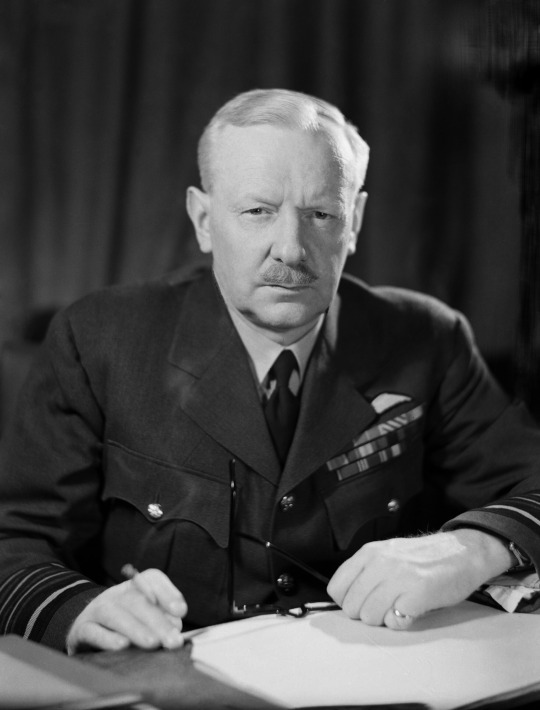
The Necessity of Dresden and its Controversy:
The bombing of Dresden, a cultural and historical city, has been a subject of heated debate. While the destruction was significant, it is important to contextualize it within the broader strategy of defeating Nazi Germany. Dresden was not a random target but a legitimate military and industrial center, serving as a transportation hub and housing military facilities. The controversial decision to bomb Dresden needs to be understood in the context of the prevailing circumstances and the desperate measures deemed necessary to bring the war to a close.
RAF Bomber Command's Contribution to Victory:
Despite the controversies, RAF Bomber Command played a crucial role in weakening Germany's war machine. The strategic bombing campaign significantly disrupted German industry, transportation, and morale, contributing to the ultimate defeat of the Axis powers. The sacrifices made by the bomber crews cannot be overlooked, as they faced extreme danger and often paid the ultimate price in pursuit of victory.
While history may question the morality of certain decisions made by RAF Bomber Command, it is essential to recognize their indispensable contribution to the Allied victory in World War II. The context of wartime decisions and the challenges faced by leaders like
Arthur Harris must be considered to appreciate the complex nature of strategic warfare. RAF Bomber Command, controversial as it may be, played a vital role in securing the freedom and peace we enjoy today.
#RAFBomberCommand#WorldWarIIHistory#StrategicBombing#ArthurHarris#WWIIVictory#MilitaryLeadership#DresdenBombing#ControversialDecisions#AlliedForces#AirWarfare#HistoricalPerspective#WarStrategies#RAFHistory#BomberCrews#WarfareEthics#MilitaryCampaigns#WarTimeLeadership#RAFContribution#AlliedVictory#HistoricalDebates#history#new blog#today on tumblr
0 notes
Text
Hidden Secrets Unveiled: The Fascinating Story of the Nazi Gold Train Heist | Disappear TV
youtube
Step into history with Disappear TV as we uncover the captivating tale of the Nazi Gold Train Heist. Join us as we delve into the hidden secrets, facts, and legends, surrounding this fascinating story of World War II history. Explore the mysteries and treasures that continue to intrigue the world. 🔔 SUBSCRIBE TO DISAPPEAR_TV ► https://www.youtube.com/channel/UCOXm-1g8074XjyzKXM05ZLg 💥ABOUT DISAPPEAR TV💥 Our videos prioritize informative and educational content while avoiding the glorification of violence or endorsing harmful actions. We take care to bleep or exclude violent words and refrain from explicit details on sensitive events. Our documentaries are dedicated solely to educational purposes, ensuring reliability through thorough research, careful editing, and original narrations. We are committed to fostering a safe and respectful viewing experience for all audiences, offering valuable insights without promoting any specific views or ideologies. Our platform encourages critical thinking and learning, shedding light on various subjects to promote understanding and knowledge. 📷 Checkout Other Videos 📷 📌Unveiling the Dunbar Armored Robbery: Unraveling Inside Job or Perfect Heist?" 🔗https://youtu.be/GAB_tb1gGxs 📌El Chapo's Escape: The Unforgettable Tunnel Escape Route to Freedom
#NaziGoldTrain#WorldWarIIHistory#TreasureHunt#HistoricalMysteries#EducationalContent#DocumentarySeries#HiddenSecrets#ExploreHistory#SubscribeNow#EducationalEntertainment#Youtube
0 notes
Photo

I'm starting a new deep dive down the @history rabbit hole. Hunting Hitler is a three season documentary which chronicles of the attempts of a team led by 21-year CIA veteran Bob Baer and war crimes investigator John Cencich to discover if Adolf Hitler faked his death in 1945 and made his way to Argentina and possibly other places. Let's go!!!
#HuntingHitler #Hitler #AdolfHitler #WorldWarII #WorldWarIIHistory #20thCenturyHistory #History #Historia #Histoire #Geschichte #HistorySisco
https://www.instagram.com/p/Cg8J6EuuHef/?igshid=NGJjMDIxMWI=
#Hunting Hitler#Hitler#Adolf Hitler#World War II#World War II History#20th Century History#History#Historia#Histoire#Geschichte#HistorySisco
3 notes
·
View notes
Link
Check out this listing I just added to my Poshmark closet: 1940s Eagle antique vintage solid brass wall hook gold tone Americana USA 🇺🇸.
0 notes
Text
Ghost Blimp: The Mystery and Missing on the L-8
On Sunday, August 16th 1942 Richard L. Johnston was going about his business. He had just finished waxing his car in Dale City, California when he looked up and saw something huge creeping out of the sky and towards his house. Suddenly it hit a utility pole, electrical wires broke sending sparks cascading down to the street, and Johnson ran into the house to protect his mother. When he came back outside there was a large group of people in the street including Fire Deputy Marshal Sean Wood and Johnston’s next door neighbor, volunteer fireman William Morris. Johnston’s car was completely hidden under a massive fold of what looked like canvas. When Johnston woke up that morning he probably didn’t expect that a blimp would land on his car that day. And yet, moments later the scene became even more bizarre.
In August 1942 the United States Navy was on high alert. Within nine months after entering World War II Japanese submarines sunk at least six Allied ships off the American west coast and shelled one of California’s largest oil drilling facilities. The fear of another attack on American soil was high and in order to keep an eye on the sea along the west coast the Navy took to the air, deploying blimps to cruise over the ocean and watch for any suspicious activity.
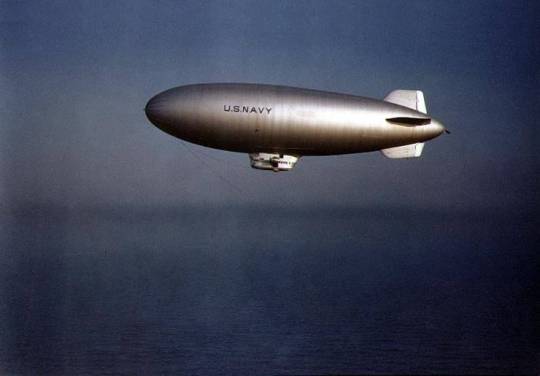
World War II Navy blimp. Image via Wikimedia Commons.
The blimp that landed on Johnson’s car was the L-8 airship, acquired by the Navy from the Goodyear company and commissioned on March 5, 1942. It was an excellent machine, completing over 1,000 trips and never requiring any work beyond routine maintenance. The two-man crew tasked with piloting the airship had records as impeccable as the craft itself. Lieutenant Ernest Dewitt Cody was a 1938 graduate of Annapolis and although he was only twenty-seven years old he was highly regarded with his commanding officer describing him as “one of the most capable pilots and one of the most able officers” under his command. Cody was relatively new to flying LTA (lighter-than-air) airships, but in April 1942 he proved his ability when he flew the L-8 to deliver cargo to the USS Hornet before the ship departed for Doolittle’s Raid over Tokyo. It was that trip that earned him his promotion to Lieutenant in June 1942. Ensign Charles Ellis Adams was eleven years older than Cody and had twenty years of experience flying LTA airships, but only earned his commission the day before their flight together making his trip with Cody his first flight as an officer.

Lieutenant Ernest Dewitt Cody and Ensign Charles Ellis Adams.
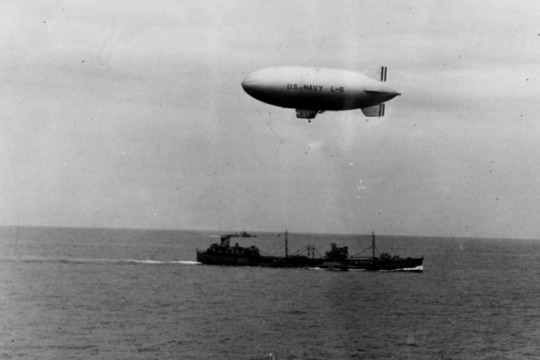
The L-8 delivering cargo to the USS Hornet. Image via National Archives.
Their task together was a routine anti-submarine mission, fly out from Treasure Island, patrol a fifty-mile radius of San Francisco, then head to the Farallon Islands before heading back to Treasure Island. When they left Treasure Island at 6:03am there was approximately five miles of visibility with the Golden Gate Bridge off in the distance. At 7:38am Cody radioed Moffett Field and reported their location as being four miles east of the Farallon Islands. Four minutes later Moffett Field received a second message from Cody, “Am investigating suspicious oil slick—stand by.” Since an oil slick could indicate an enemy submarine below the waves it was not unusual for the airship to investigate the scene. As the L-8 descended closer to the sea its movements were seen by a fishing boat, the Daisy Gray, and a Liberty cargo ship, Albert Gallatin. Apprehensive about seeing the Navy airship creep closer to the surface of the water and then set off two flares, the ship crews pulled in their nets, manned their guns, and nervously waited to see what happened next. But, as they watched the L-8 nothing out of the ordinary happened. The blimp circled for about an hour and crews from both ships could see two men in the gondola. At approximately 9am the blimp again rose into the air and restarted its route back toward San Francisco. Everything appeared normal to the ships and spectators below, but personnel at Moffett Field were getting nervous, they had not heard a word from the L-8 since 7:42am and were not able to reestablish any communication. Two Vought OS2U Kingfisher floatplanes were sent to look for the blimp and other aircraft were asked to keep their eyes open.

The intended flight path of the L-8 aircraft. Image via unsolvedmysteries.fandom.com.
At approximately 10:49am a series of blimp sightings began to roll in. A Pan American Clipper pilot reported seeing the blimp over the Golden Gate Bridge, then at 11am one of the Kingfishers spotted the L-8 three miles west of Salada Beach at approximately 2,000 feet. Although a height of 2,000 feet would typically be avoided by an airship for safety reasons, there was no indication of the ship being out of control or in danger and it began to descend. The next plane to spot the blimp, an Army P-38 pilot, also saw no indication that the airship or its crew was in any distress when it was seen near Mile Rock, seemingly on its way back to Treasure Island. Within minutes an off-duty seaman named Richard Quam saw the L-8 as he was driving along the highway between San Mateo and San Francisco and he decided to take a picture of the sight. He may have been the first person to capture that something was amiss, the blimp was now noticeably bending in the middle.
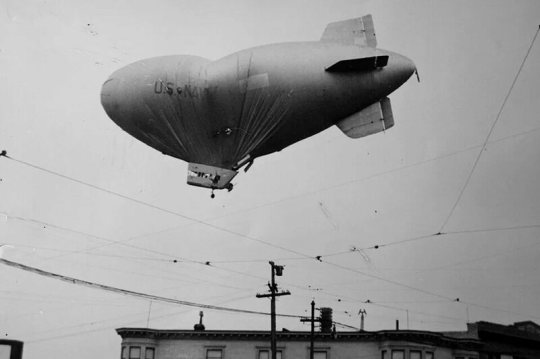
The L-8 airship visible sagging as it flew over Daly City. Image via National Archives.
Things began to happen quickly. At approximately 11:15am the L-8 was seen approaching the shore of Ocean Beach in San Francisco but its motors were now silent and there was noticeable sagging. It touched down on the beach for a moment but kept moving until it hit the side of a hill, knocking off one of its 325lb depth chargers. Now carrying 300lbs less, the airship again rose, clearing the hill, and moving further inland. Thousands of people now watched as the L-8 staggered overhead obviously in peril. But, according to witnesses, the ship was not unmanned, in a later interview seventeen-year-old C.E. Taylor told reporters that as the blimp descended he was watching the cabin through his binoculars and that two men were clearly visible inside the entire time.
Finally, at 11:30am the blimp came to a clumsy rest on top of Richard Johnston’s freshly waxed car. Sirens blared and firemen surrounded the blimp, slashing it open in an attempt to save Cody and Adams inside. But, when the rescuers got to the gondola they found a scene that made no sense. The door was open, the microphone for communication was hanging from the doorway, a hat was resting on the controls, the life raft and all parachutes were still in place, but Cody and Adams were nowhere to be found.
Once the initial shock of the crash wore off a feeling of worry began to quickly take over. The L-8 was traveling an extremely visible route and was tracked and seen by hundreds of people and ships, with many reporting the same as young C. E. Taylor, that the men were visible inside the cabin. The Navy immediately launched a search for Cody and Adams and the craft was inspected for any clues to solve the disappearance. The engines were in perfect running order, the ignition switches were on, and there was four hours of fuel left. The only thing that was unusual on board was that the blimp's batteries were drained and part of the fuel supply had been dumped out with no obvious explanation why.
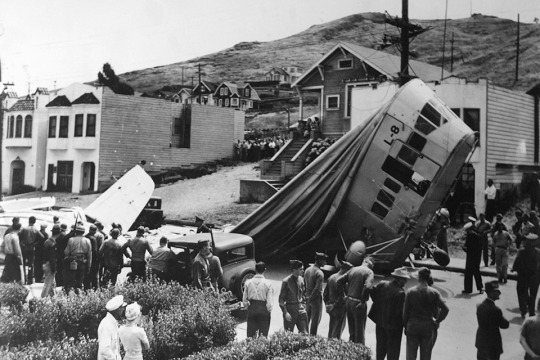
The scene after the crash of the L-8. Image via National Archives.
For three days the shore where the blimp initially crashed and the Pacific coastline was heavily searched but there was no trace of the two missing men. A board of investigation was convened by Navy Commander Francis Connell and over the course of seven days thirty-five witnesses gave their testimony of watching the L-8 hover overhead with nothing seeming suspect. Multiple people both on land and at sea at the time reported seeing the men inside and there being no indication that they ever fell or jumped out of the gondola. In the end it was determined that "no fire, no submersion, no misconduct, and no missiles struck the L-8.” While that may have answered some questions the big one still remained, what happened on the L-8 between 7:42am and 11:15am that made two Navy officers stop communication and vanish before crashing their blimp in a residential neighborhood?
Unfortunately, there were many theories but no concrete answers to that question. Some believed it was a simple tragic accident, that a malfunction with the door led to one man falling out at a low altitude and the other following him out in an attempt to save him before they were both lost to the sea. Others proposed much more elaborate theories, that the men were secret spies, that they were lured close to the surface of the water and grabbed by enemy forces, and some even said that the men ended up killing each other by falling out of the blimp during an argument over a woman. Some guesses tried to remain optimistic, that the men fell out but they were able to swim to shore and would be found hiking back to civilization any day now. Maybe they were picked up by a passenger ship after falling from the aircraft, they just had to wait until they were returned home. But, time ticked forward and the men never reappeared. Shortly after the crash the wives of both men were told that their husbands were officially missing. It was becoming painfully obvious this was not going to change and one year after their disappearance the men were declared dead. The Navy officially classified the incident as “100% Unknown/ Undetermined.”
The L-8 was repaired and continued to be used as a training vessel until the end of World War II when it was returned to Goodyear Tire and Rubber Company. It was refurbished, renamed America, and was used to broadcast sports events until it was finally retired in 1982.
Nearly eighty years after the disappearance of Lieutenant Ernest Dewitt Cody and Ensign Charles Ellis Adams there is still no official explanation as to what happened on that clear August morning over the Pacific coast
After its retirement the gondola of the L-8 was fully restored and is currently exhibited at the National Museum of Naval Aviation in Pensacola, Florida.
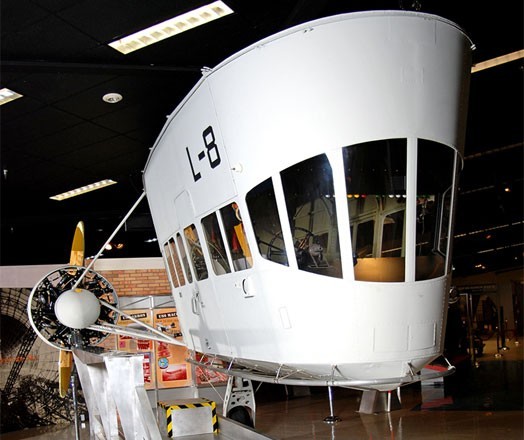
The refurbished gondola of the L-8 on display at the National Museum of Naval Aviation. Image via www.history.navy.mil.
*************************************************
Sources:
Mystery of the Ghost Blimp by John J. Geoghegan https://www.historynet.com/mystery-of-the-ghost-blimp.htm.
The Crew of the L- 8, https://unsolvedmysteries.fandom.com/wiki/The_Crew_of_the_L-8
The Bizarre Tale Of The World War II Ghost Blimp And Its Missing Crew by Gina Dimuro, https://allthatsinteresting.com/ghost-blimp
In 1942, a war blimp fell out of the sky onto Daly City. Its crew was never found by Katie Dowd and Andrew Chamings, https://www.sfgate.com/sfhistory/article/SF-Ghost-blimp-Daly-City-15739903.php
Ghost Blimp Mystery of WW2 – Crashed in San Francisco & Crew Was Never Found by Ruslan Budnik, https://www.warhistoryonline.com/instant-articles/mystical-disappearance-pilots.html.
#HushedUpHistory#featured articles#world war ii#WWII#airship#WorldWarIIhistory#wwii history#californiahistory#unsolvedmysteries#unsolved#mystery#weirdhistory#strangehistory#scaryhistory#forgottenhistory#horrorstory#scarystory#historyclass#historyisnotborning#creepyhistory#wheredidtheygo#historicmystery#historiesmysteries#truth is stranger than fiction#truestory#weirdstory#blimp#L8#ghostblimp
73 notes
·
View notes
Text
Another ⭐️⭐️⭐️⭐️⭐️ book of 2021 is Our Darkest Night by Jennifer Robson! This book is one of the best historical fiction books I’ve read this year. It is set during World War II in Italy and is about a young Jewish girl named Antonina. She must leave her family and hide in the Italian countryside posing as the wife of the farmer Niccolò as the threat of deportation is upon her by the Nazis. They pretend to be a married couple but along the way Antonina and Niccolò develop a relationship even a war cannot stop. I really enjoyed the love story of the two of them. It did not feel forced, it felt like two people really learning to love and trust one another. Niccolò is a moral man and I appreciate his ability to do what is right and help those out in need. I also appreciated Antonina’s bravery in leaving her home for something completely new to her in order to survive. This is a fictional book but to me the story of love that comes out of it is very much real. Robson wrote characters almost too good to be true, but the way they fall in love with one another in a tragic era is actually very natural. It shows the hardships people have faced but also highlights the importance of love in hard times. #books #historicalfiction #worldwariihistory #worldwariihistoricalfiction #ourdarkestnight #jenniferrobson #literature #fivestarbooks #booksof2021 #bookrecommendations #fiction #recommendedreading #bookcommunity #readers

0 notes
Link
Check out this listing I just added to my Poshmark closet: 1940s Eagle antique vintage solid brass wall hook gold tone Americana USA 🇺🇸.
0 notes
Link
Check out this listing I just added to my Poshmark closet: 1940s Eagle antique vintage solid brass wall hook gold tone Americana USA 🇺🇸.
0 notes
Link
Check out this listing I just added to my Poshmark closet: 1940s Eagle antique vintage brass wall hook.
0 notes
Link
Check out this listing I just added to my Poshmark closet: 1940s Eagle antique vintage brass wall hook.
0 notes
Link
Check out this listing I just added to my Poshmark closet: 1940s Eagle antique vintage brass wall hook.
0 notes
Text
To Neptune! The Navy and the Pig who Became King
When the item up for bid hit the auction stage it was hard to tell what the eager crowd noticed first. It was huge, somewhere between 200 and 300 pounds, and the colors of red, white, and blue struck deep into the hearts of the people of Illinois who still had the attack on Pearl Harbor fresh in their minds. In the era of World War II pork was hard to come by and when the bidding for the pig began it rained in with a fury. Someone offered $100 for a leg, another offered $300 for the shoulder, and amid it all the pig stood blinking calmly while his price rose higher and higher. When the bidding ended he had brought in thousands of dollars and his new owner was ecstatic, but only for the one minute that he owned him. At the end of the night the pig went home with the same person he arrived with and the bidders went home with their fistful of papers. They all knew they were never actually going to go home with a piece of meat, and they were fine with it. This was no ordinary pig, this was King Neptune, and he was going to build a battleship.
When King Neptune was born at Sherman Boner’s farm in 1942 he was the runt of the litter and Sherman’s daughter Patricia decided to raise him as a project for her local 4-H Club. The farm was located in West Frankfort, Illinois, less than an hour away from the hometown of Navy recruiter Don C. Lingle. The Navy was deep in efforts to construct new battleships and Lingle was looking for ways to raise funding for the building of the USS Illinois, a ship scheduled to be completed in Philadelphia by May 1st 1945. Money for the ship was hard to come by, but so was pork and Sherman told Lingle he could donate the pig to him to use for a fundraising pig roast. When Lingle picked up the pig, originally named Parker Neptune, he found that he could not bring himself to slaughter the animal, stating later in an interview that Parker was “an innocent looking thing.” He soon came up with an idea to keep the pig alive and still raise money for the ship. He would symbolically auction off Parker but instead of a piece of pork the bidders would walk away with war bonds.

World War II advertisments for war bonds.
Partnering with auctioneer L. Oard Sitter, Lingle took Parker Neptune to a fundraising event in Marion, Illinois and billed him as a new mascot for the Navy. Parker’s coloring was red and white and before he was presented to the masses Lingle draped a navy blue blanket over his back, pulling at the patriotic heartstrings of everyone present. When the bidding started it took off like wildfire with people pledging hundreds of dollars for a “part” of Parker. By the end of the night he raised over $11,000 and earned himself a new name, King Neptune.

King Neptune. Image via The Collection of Union County Historical and Genealogy Society: Cobden, Illinois.
King Neptune’s next appearance proved that his success at the first auction was no fluke. The bidding was furious and the enthusiasm for the patriotic pig only grew stronger. Soon Lingle and Sitter were accompanying him to fundraising events all over Illinois, arriving at each location in a special truck provided by the Future Farmers of America. The blanket was eventually replaced by a purple and gold robe emblazoned with his name, his hoofs were painted, and he wore a gold crown gifted to him by the Illinois Women's Club. After every auction the winner was technically allowed to claim King Neptune and bring him home, but no one ever did. They would “own” him for one minute before officially handing him back to Lingle and going home with their war bonds and stories of winning the great King Neptune.

Illustration of King Neptune appearing in the St. Louis Post - Dispatch on June 18th 1950. Image via npr.org.
Everyone loved King Neptune and with each event he not only raked in the donations but he also collected a number of honorary memberships to many of the Elks lodges that sponsored his appearances. As his popularity grew, so did the bidding and each auction was regularly pulling in $50,000 or more to go to the Navy and the USS Illinois. At one point someone even paid $25 to “own” a squeal from the King. On March 6th 1943 one of his hairs sold for $500, but that was not the most stunning bid of the night. At the same auction Dwight H. Green, the governor of Illinois, bought King Neptune on behalf of the state for the price of one million dollars. But, like so many before him, he happily claimed his one minute and then returned the pig to Lingle to continue his fundraising efforts.
As the original completion date of May 1st 1945 came and went the USS Illinois was still under construction. King Neptune raised a staggering nineteen million dollars for the effort (today’s equivalent of 250 million) but it was still not enough to save the ship. The project was officially cancelled on August 11th 1945 with only 22% of the ship complete.

The USS Illinois shortly before construction was ceased. Image via wikipedia.
With the USS Illinois officially cancelled and World War II coming to an end later that year, King Neptune’s fundraising days were complete. He raised a huge sum of money and was approaching a hefty 500lbs when it was decided that it was time for him to retire. Shockingly, King Neptune was originally supposed to end his days in the meat packing plants of the Chicago Stockyards but Lingle would not allow that to happen to his friend. He gained ownership of King Neptune and arranged for him to live the rest of his days in comfort at a farm owned by Ernest Goddard. The Goddard family treated the pig true to his name, chauffeuring him around in the back of their trucks and guiding him around the farm by tapping his shoulders when his weight of 700lbs partially impaired his vision.
King Neptune lived happily on the Goddard Farm until succumbing to pneumonia in 1950 just short of his eighth birthday. Upon his death he was given an official Navy funeral with full military honors and buried just outside Anna, Illinois with a headstone remarking how he “helped make a free world.”
Over time wear, vandalism, and the construction of a highway took its toll on the pig’s tombstone and it was replaced with a sturdier and more prominent flat marker. Today the memorial for King Neptune can be found at the Trail of Tears Tourist Information Center in Anna, Illinois nestled amid the oak trees and next to a bench where tourists can sit and read the simple inscription for the “Navy Mascot Pig”:
“Raised by Patty Boner, West Frankfort; Given to Navy recruiter Don Lingle, Anna; and auctioned by L. Oard Sitter, Anna; around the state of Illinois for over $19,000,000 in WWII war bonds.”

King Neptune memorial. Image via wikipedia.
#husheduphistory#featuredarticles#illinois#Illinoishistory#USNavyhistory#Navyhistory#Navalhistory#world war ii#WorldWarIIhistory#WorldWarIImascot#warbonds#fundraising#famousanimals#pig#famouspigs#mascot#famousmascots#history#WorldWarIINavy#battleship#forgottenhistory#weirdhistory#animal stories#somepig#animalsinhistory#historyisfun#historyisnotborning#kingneptune#history class#funhistory
0 notes